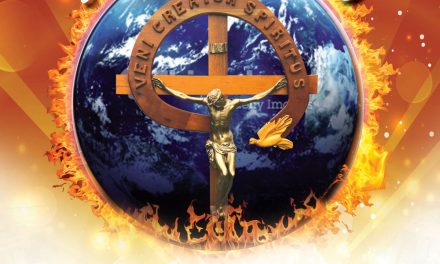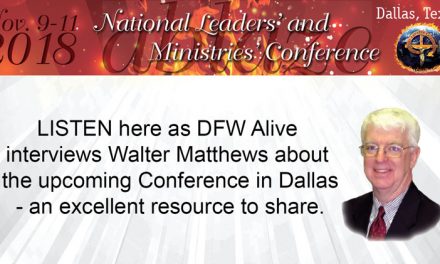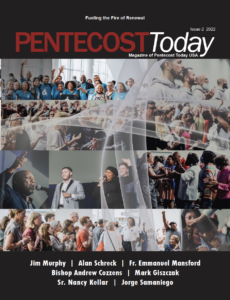YEAR OF JUBILEE 2017
Document issued by the 5-Year Committee of the National Leadership Groups of the Catholic Charismatic Renewal in the U.S.
Download the Statement on the Year of Jubilee
AN INVITATION
Saint John Paul II wrote of the Great Jubilee of the Year 2000: “Every Jubilee year is like an invitation to a wedding feast.” He continued, “The term jubilee speaks of joy; not just an inner joy but a jubilation which is manifested outwardly.” The Great Jubilee was a time to celebrate the coming into human flesh of our God in the person of Jesus of Nazareth, a time to celebrate our salvation and invite “everyone to rejoice.”
The upcoming 50th Anniversary of the outpouring of the Holy Spirit amongst college students and professors on the Duquesne Weekend in February 1967 at The Ark and The Dove Retreat House near Pittsburgh is an invitation to such a wedding feast and an invitation to rejoice.
It may well be, as Pope Francis has said of the Extraordinary Jubilee of Mercy, an “extraordinary time of grace,” a “year of the Lord’s favor.”
PART I: JUBILEE
The Great Jubilee of the Year 2000, the Extraordinary Jubilee of Mercy as well as the Charismatic Renewal’s First Jubilee have their origins in the Israelite custom of jubilees, in Jesus’ self-appropriation of the jubilee themes to himself, and in the Church’s rediscovery of jubilee holy years beginning with Pope Boniface VIII.
The key Biblical texts are from Leviticus 25, Isaiah 61 and Luke 4. As one author put it:
The core jubilee teachings may be summed up in this way:
- You shall let the land lie fallow, that is, you shall practice Sabbath;
- You shall forgive debts, letting forgiveness in;
- You shall free captives and proclaim liberty;
- You shall find out what belongs to whom and give it back;
- You shall hold a great feast, learning to sing the canticle of “Jubilate.”
Fast-forwarding from the Biblical texts to the origins of the Catholic practice of holy year/jubilee, we find that “the very first holy year in 1300, called by Pope Boniface VIII, is connected to [the] devotional penitential movement present in the Church at that time.” Almsgiving, doing works of mercy, and making pilgrimages were aspects of this movement. Men and women came to Rome motivated by a desire for freedom from the guilt of their sins.
The Pope granted a special indulgence to the pilgrims. It was, however, not until 1350 and the next holy year called by Pope Clement VI that the “jubilee year was specifically linked to the Jewish practice of the jubilee in ancient Israel.” “Over time the jubilee year came to be understood as a Christian version of the themes of release, forgiveness, and reconciliation of the Jewish jubilee.”
When our Lord stood in the Synagogue in Nazareth and quoted Isaiah: “The Spirit of the Lord is upon me” and ended with “This text is being fulfilled today” he brought together in his person the emphases of social justice and personal and communal conversion and forgiveness contained in the Old Testament texts. “He personifies the Jubilee,” as one author put it. Authentic jubilee spirituality cannot be found apart from the person of Jesus Christ.
Nor can it be found apart from life in the Spirit begun in Baptism and renewed in “baptism in the Holy Spirit.” Saint Pope John Paul II wrote that if we are “docile to the action of the Holy Spirit” a “new springtime of Christian life…will be revealed…. What was accomplished by the power of the Holy Spirit ‘in the fullness of time’ can only through the Spirit’s power now emerge from the memory of the Church.” It is in this sense of something emerging that has been locked in the “memory of the Church” that we can best understand the renewed experience of and interest in “baptism in the Holy Spirit” in our day.
The outpouring of the Holy Spirit we celebrate this coming year is “a life-transforming experience of the love of God the Father poured into one’s heart by the Holy Spirit, received through a surrender to the lordship of Jesus Christ.” (ICCRS, Baptism in the Holy Spirit, p13). “Through baptism in the Spirit the experience of the first Pentecost has been made present anew in our time.” (ibid) This recovery of Pentecost is an experience of jubilee: of freedom from the bondage of sins into the marvelous light of being sons and daughters of a loving Father; of empowerment to live in the power of the Spirit and in turn to proclaim Jesus to others, “to show mercy” (Pope Francis) by our lives and actions.
PART II: A SHORT HISTORY
The Catholic Charismatic Renewal dates itself from February 18, 1967. It was on that day when a number of Duquesne University students experienced baptism in the Holy Spirit during a weekend Retreat at The Ark and The Dove Retreat Center near Pittsburgh. Very quickly after that, through contacts of friends and campus ministers, this experience of baptism in the Spirit spread to Notre Dame University, and East Lansing and Ann Arbor, Michigan. In a series of prayer meetings and hastily put together Conferences, the experience was shared across the United States in hundreds of locations by the end of 1967. In one Conference, a prophecy was given that baptism in the Spirit would go across the nation like lightning from coast to coast – and certainly in that year that is what seemed to happen.
International Movement
Still without structure, the current of grace, which is the outpouring of the Holy Spirit in the experience of baptism in the Spirit, was experienced in other countries. The first sharing was by American missionaries working in foreign countries, and then by the natural back-and-forth among immigrant people. In the late 1960’s, Puerto Rico and Colombia already had “charismatic retreats” to assist people in experiencing baptism in the Spirit. From those two centers, this current of grace washed all of Latin America – Mexico, Central America, South America and Brazil, and the Caribbean. Today there are millions of people there who have experienced baptism in the Spirit.
Not long after, again beginning with American missionaries, the current of grace reached the shores of Africa; and the Catholic countries of Asia and the Philippines; and Europe. Then, because of the migrations of people to and from America, immigrants from these countries brought their charismatic experience back to America from where it originated, and it has become a major part of immigrant church life in the United States.
Two Ways
In the 1970’s, the Renewal grew fast and wide. Thousands of people attended large conferences across the country. Soon it became apparent that there were two major ways of “being charismatic” in the Catholic Church. One way was by belonging to a covenant community – a group of people led by the Lord to “covenant” their lives together. The other way was to belong to a prayer group who gathered usually on a weekly basis to praise the Lord, and grow in their life in the Spirit through exercising various charisms. These two models have developed over fifty years into varied Renewal experiences.
Structures
The fast growth of the experience necessitated organization. In the 1970’s in the United States: recognized leaders in the fledgling Renewal formed the National Service Committee to provide service, leadership and vision. Then an Ad Hoc Committee of Bishops urged every Diocesan Bishop to appoint a liaison – someone who would relate the Bishop to the Renewal in his Diocese. The newly appointed liaisons formed an Association of Diocesan Liaisons, which seeks to gather the liaisons on a yearly basis to provide them with theological and pastoral foundations for charismatic life.
As the various immigrant groups in the United States grew in charismatic experience, they also sought to organize on a national level. In 1990, Hispanics and Haitians both organized their own national committees. The Filipinos here also organized an Alliance. The Koreans here have sought to organize nationally. Other ethnic groups – including Indians, Portuguese-speakers, Vietnamese, Indonesians and West Indians – have all organized for the purpose of pastoring the charismatic experience. In Latin America, leaders organized CONCCLAT – a Committee for the Renewal in all the Latin American countries. More recently, the Hispanic Renewal has become a member.
Aware that the experience of baptism in the Spirit was growing throughout the entire Church, efforts were made in the ‘70s to network on an international basis. With the assistance of Cardinal Leon Suenens of Belgium, twelve leaders of the Renewal met with Pope Paul VI in 1974. This led to a charismatic gathering in Rome in 1975 and a celebration in St. Peter’s Basilica where Pope Paul VI called the Charismatic Renewal a “chance for the Church”. By 1978, an international office for the Renewal was set up in Brussels (through the patronage of Cardinal Suenens) which later moved to Rome and renamed the International Catholic Charismatic Renewal Services (ICCRS).
Those involved in the experience of covenant communities have also organized on an international level. Some of the communities have international branches. Urged by the Pontifical Council for the Laity, many of these communities now belong to the Catholic Fraternity of Charismatic Covenant Communities and Fellowships. In 2015, at the urging of Pope Francis, ICCRS and the Catholic Fraternity combined their offices in Rome, to strengthen their “one single Service to the worldwide Charismatic Renewal, which represents the single current of grace, without losing each one’s own characteristics.” (Pope Francis)
Ecumenism
The current of grace does not exist only in the Catholic Church. The Lord has been very generous with the gift of the Spirit. Pentecostal churches began to arise in the United States since 1900 after the Topeka, Kansas experience, followed by the Azusa Street outpouring in 1906. In the 1960’s, some “mainline Protestant churches” began to experience a “charismatic renewal” – especially Episcopalians and Lutherans. More recently, a number of “non-denominational churches” have also had an outpouring of baptism in the Spirit. Thus, in the Christian world, there is a natural alliance among these four groups – classical Pentecostals; charismatic denominational Christians; non-denominational charismatics; and Catholic charismatics.
This has led to many actions and prayer for unity. Many of the covenant communities are ecumenical. Many ecumenical charismatic prayer services have been held.
In the mid ‘70s, leaders in the four “streams” formed an ecumenical committee and convened a 50,000 participant Ecumenical Conference in Kansas City in 1977. Later the Committee was re-configured as the North American Renewal Services Committee (NARSC). This Committee sought to gather participants from all four “streams” noted above. It succeeded in organizing several national ecumenical Conferences: a Leaders Conference in 1986 in New Orleans and then a General Conference in 1987 also in New Orleans. NARSC later held conferences in 1990 in Orlando; in 1995 in Indianapolis; and in 2000 in St. Louis. Similar efforts have occurred internationally.
Charismatic Expressions
In addition to the Catholic Charismatic Renewal and the ecumenical covenant communities, many other Catholics experience and promote baptism in the Spirit and the all that springs from it: the centrality of the Lordship of Jesus; the importance of Scripture for living; the use of charisms in ministry and evangelization; and communal Spirit-filled prayer. These groups and individuals also relate to this fifty-year experience of the outpouring of the Spirit in the Catholic Church. There are ministries and renewal movements in many places. Just to mention a few: Christian Healing Ministries, Life-Teen, Franciscan University of Steubenville ministries, Escuela Juan Pablo II, Escuela Andrés, el Sembrador, and National Evangelization Teams (NET).
(For more on the Renewal’s history see, among others, Celebrating a Charismatic Jubilee by Fr. Bob Hogan, BBD).
PART III: FRUITS OF BAPTISM IN THE HOLY SPIRIT
As we have looked back and seen briefly how the outpouring of the Holy Spirit has grown in our day, it is important that we look at the fruit that this move of the Spirit has borne in the Church and for the world.
Change of Life
The first fruit of this move of the Spirit is primary both in chronology and in importance. From the beginning, lives began to change and love began to grow. An increase in love for God and in love for others was evident from the very beginning. Baptism in the Holy Spirit is a call to receive the Father’s love and for individuals to enter into a personal relationship with Jesus and to become disciples. With this infusion of grace, individuals began to be transformed and with that the motivation and the ability to love has increased. Therefore, the first fruit is literally millions of individual lives that have been touched, loved, transformed and changed. Changed lives have grown other fruits. Individuals began to grow in their love for the Church, Mary, and the Saints. There has been a rediscovery of and a hunger for prayer, Scripture and the sacraments. A hunger for holiness and the power to pursue it has grown.
Relationships
This change in individuals has also borne relational fruit. People who had been touched by this grace began to gather in prayer groups, communities, and associations to share their lives and experience. Prayer, praise and worship together became a hallmark and a fruit of renewal. Baptism in the Spirit has always carried with it a relational component that has helped individuals grow by providing mutual support for formation and healing. Individuals touched by God’s love have drawn together to support one another in living the life in the Spirit. Ministries of healing and deliverance have developed to bring wholeness to those who want to be more like Jesus but are hindered by the work of the world, the flesh, and the devil.
Communities
As people began to draw into communities of love and support they were brought into relationship with others who had been baptized in the Spirit who were not all from the same racial, ethnic, denominational, or age group that the individuals usually embraced. Baptism in the Spirit has produced opportunities to grow in a love that embraces unity with diversity. One important element of this fruit has been an ecumenical impulse. Just as in Scripture, baptism in the Spirit has required us to work at removing barriers and accepting one another as brothers and sisters in Christ. In many parts of the world, this impetus toward unity has increased our hunger and willingness to work for social justice.
Mission
Finally, baptism in the Holy Spirit has brought with it a missionary impulse. The Holy Spirit has poured out charisms in abundance to build the Church and to evangelize the world. Many vocations to the priesthood, diaconate, and religious life have come forth from those baptized in the Spirit. Baptism in the Spirit has mobilized the laity to be a missionary force for the new evangelization. The charisms, including signs, wonders and miracles are beginning to move out of the prayer groups and into the streets. The fruit of fifty years of renewal are many.
(For more on the fruits of baptism in the Holy Spirit and the Renewal see Baptism in the Holy Spirit, pp 16-26).
PART IV: WHAT WE HAVE LEARNED
As noted above, our Jubilee is a time to rejoice and celebrate, but it is also a time to look back on what we have learned over the last fifty years of the Catholic Charismatic Renewal. Here are some of the important things that we have learned, and we need to remember and apply, so that we can grow in wisdom and maturity as a “current of grace,” and as an Ecclesial Movement in the Church:
1) Catholic Charismatic Renewal needs to understand itself as both a “current of grace” and “an ecclesial movement”: Be open to both special outpourings of grace (revival graces), and step-by-step building with the Lord led by the Holy Spirit. The whole movement is a “charism” for the Church, so we are more powerful in the Holy Spirit when we stay united with the International, National and Diocesan Offices (Centers, Leadership Teams) for Catholic Charismatic Renewal, rather than staying isolated in our groups or ministries.
2) We need to integrate being both “fully Catholic” and “fully charismatic”: Recent popes have called us not to lose our “prophetic” call to remind the Church to be open to all the workings of the Holy Spirit and to live a fully charismatic life. Let us seek to grow in the knowledge of our Catholic faith so we can integrate charismatic experiences with all of the Catholic faith.
3) We need an “experience” of baptism in the Spirit, but also a “lifestyle” in the Spirit: Pope Francis has confirmed that baptism in the Spirit is meant for the whole Church. We seek to be a reminder in the Church of the “full role” of the Holy Spirit (union with God; transformation for holiness; ministry empowered by the charisms; building community). Our relationship with the Holy Spirit should influence every part of our lives. We should not be just “experience seekers.”
4) We need a unity of mind and heart to accomplish fully God’s purpose for the Renewal: We need a heart for unity, building community, and ecumenism. This includes unity with the International Renewal and among the various expressions of the Renewal in prayer groups, covenant communities and ethnic groups. Being an active part of a community of faith and prayer is essential for full life in the Spirit. Seeking Christian unity is an essential element of the Charismatic Renewal.
5) We need the full, mature, and discerned use of the charisms (spiritual gifts): Some of our groups show little use of the charisms, and in other places, the gifts do not come under enough community discernment. We need to understand how charisms are to be part of our daily life and parish life. We are to use the gifts for service, evangelization, building community, healing, spiritual warfare, empowerment, etc.
6) Our teaching needs to include inspiration, education, and practical wisdom: Sometimes we have focused so much on inspiration that we do not have good roots from education and practical wisdom. We need ongoing leadership development for our groups, including approaches to raising up new leaders, and building leadership teams.
7) We cannot lose the importance of praise and worship: We need to go beyond singing praise hymns to having a regular practice and attitude of praising God.
(For more on what we have learned see Celebrating a Charismatic Jubilee.)
PART V: GOING FORWARD
As we eagerly await the “surprises of the Spirit” that will unfold in our first Jubilee Year and the next fifty years here are four areas in which we need to make every effort to cooperate with the Spirit in moving forward. None is new; all require our attention and prayer.
Unity
First, pray and work for unity – unity in all our relationships, especially those in the Renewal, and unity in the Body of Christ. Pope Francis said to us in 2014 “I expect that you give witness of spiritual ecumenism with all those brothers and sisters of other Churches and Christian communities who believe in Jesus as Lord and Savior…Seek the unity of the Renewal, unity that comes from the Trinity.” The Holy Father calls us to seek unity in diversity. Such unity is hard but necessary for God’s purposes in this outpouring of the Holy Spirit in our day.
Next Generations
Second, as Paul wrote to Timothy, we must “pass on to reliable people [baptism in the Holy Spirit]…so that they in turn will be able to teach others.” (2Tm 1:2) Every dimension of the Renewal in the U.S. is experiencing this challenge, as is the Church as a whole. However, there is hope. We are becoming aware of a number of pockets of young adults, evangelized and baptized in the Holy Spirit who are connecting through various outreaches and through social media. They are alive in the Holy Spirit and are in turn evangelizing others and praying for them to be baptized in the Holy Spirit. They are not always connecting to the existing prayer groups and communities and other structures in the Renewal.
There is a chasm between us and them, and a footbridge. We keep waiting for them to come across to us. The Lord is telling us to go across to them, to find them and to share with them ourselves, our very lives, to do what Paul told Timothy, and certainly to pray that such will happen.
New Expressions
Third, we must accept that the Renewal is already demonstrating new forms of being together (praise and worship evenings with Eucharistic adoration, prayer meetings on the internet!), and that this trend will continue. Some prayer groups and covenant communities may not exist as they are now. What will emerge is not entirely clear. There will be a greater integration into the life of the Church. We have the two meetings of the Renewal with Pope Francis in 2014 and 2015, as well as the upcoming celebration of the Renewal’s 50th Anniversary Jubilee in Rome called together by Pope Francis, as witness. Our task, in the words of Pope Francis, is to continue to “share with all, in the Church, the grace of Baptism in the Holy Spirit.” (2014)
New Evangelization
Finally, the outpouring of the Holy Spirit, the grace of a new Pentecost, is oriented outward to the New Evangelization. As Pope Paul VI, Pope St. John Paul II, Pope Emeritus Benedict XVI and now Pope Francis have made clear: it is not possible to evangelize effectively without the power of the Holy Spirit.
Pope Francis has directed us in the Renewal in this way: first, “I expect from you an evangelization with the Word of God which proclaims that Jesus is alive and loves all men” (2014); second, “Go out into the street to evangelize, proclaiming the Gospel. Remember that the Church was born ‘in going forth’ that Pentecost morning” (2014); and third, “Be close to the poor and touch in their flesh the wounded flesh of Jesus.”
We are also to be “Spirit-filled evangelizers… [who are] fearlessly open to the working of the Holy Spirit… Jesus wants evangelizers who proclaim the good news not only with words, but above all by a life transfigured by God’s presence.” (EG, 259) Not only with words and with lives transformed, but also with signs and wonders. “Let yourselves be led by the Holy Spirit, with that freedom and, please, do not cage the Holy Spirit. With liberty!” (2014) “God himself confirmed their witness with signs and marvels and miracles of all kinds, and by distributing the gifts of the Holy Spirit in the various ways he wills.” (Heb 2:4)
Download the Statement on the Year of Jubilee
National Leadership Groups: Catholic Charismatic Renewal
Bob Canton, National Coordinator, and Ray Caparros, Board Member
Alliance of Filipino Catholic Charismatic Prayer Communities
Marianne Skrobiak, Chairperson, and Jane Barz, former member and Chairperson, DLSC
Association of Diocesan Liaisons to the Catholic Charismatic Renewal
Dan Almeter, North American Representative, and Chuck Hornsby, Committee representative
Catholic Fraternity of Charismatic Covenant Communities and Fellowships
Msgr. Joseph Malagreca, Spiritual Advisor, Andrés Arango, Coordinator, and Teresa Rosero, Member
Comité Nacional de Servicio Hispano
Msgr. Joseph Malagreca, Spiritual Advisor, and Marie Josée-Joseph, Administrator
Le Conseil Du Renouveau Charismatique Catolique Des Haïtiens D’Outre-Mer
Johnny Bertucci, Chairman, Walter Matthews, Executive Director, and Rev. Bob Hogan, BBD, former Member and Chairman
National Service Committee of the Catholic Charismatic Renewal





 Click Here for us to pray for your intentions through our new website.
Click Here for us to pray for your intentions through our new website. 
